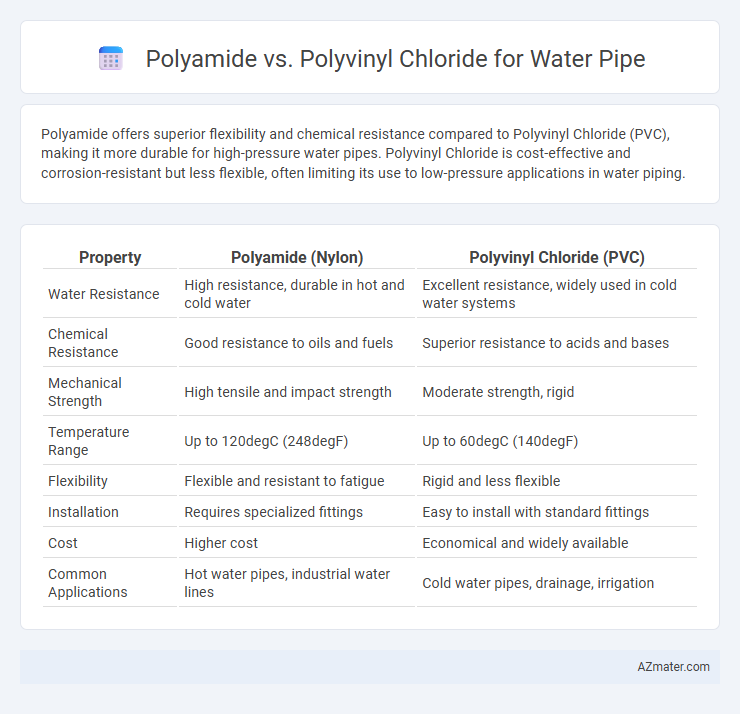Polyamide offers superior flexibility and chemical resistance compared to Polyvinyl Chloride (PVC), making it more durable for high-pressure water pipes. Polyvinyl Chloride is cost-effective and corrosion-resistant but less flexible, often limiting its use to low-pressure applications in water piping.
Table of Comparison
| Property | Polyamide (Nylon) | Polyvinyl Chloride (PVC) |
|---|---|---|
| Water Resistance | High resistance, durable in hot and cold water | Excellent resistance, widely used in cold water systems |
| Chemical Resistance | Good resistance to oils and fuels | Superior resistance to acids and bases |
| Mechanical Strength | High tensile and impact strength | Moderate strength, rigid |
| Temperature Range | Up to 120degC (248degF) | Up to 60degC (140degF) |
| Flexibility | Flexible and resistant to fatigue | Rigid and less flexible |
| Installation | Requires specialized fittings | Easy to install with standard fittings |
| Cost | Higher cost | Economical and widely available |
| Common Applications | Hot water pipes, industrial water lines | Cold water pipes, drainage, irrigation |
Introduction to Polyamide and Polyvinyl Chloride
Polyamide (PA), also known as nylon, is a strong, flexible polymer valued for its high thermal resistance and abrasion durability in water pipe applications. Polyvinyl Chloride (PVC) offers excellent chemical resistance and cost-effectiveness, commonly used for cold-water piping systems due to its rigidity and low water absorption. Both materials serve critical roles in plumbing, with polyamide preferred for demanding conditions and PVC favored for budget-friendly, corrosion-resistant solutions.
Chemical Structure and Composition Comparison
Polyamide (PA) consists of repeating amide groups (-CONH-) linked by peptide bonds, providing strong hydrogen bonding that enhances chemical resistance and mechanical strength in water pipes. Polyvinyl Chloride (PVC) features a vinyl chloride monomer with a carbon-chlorine bond, offering excellent rigidity and corrosion resistance but lower flexibility compared to polyamide. The difference in chemical composition influences their suitability for water transport applications, with polyamide excelling in impact resistance and PVC favored for its cost-effectiveness and chemical inertness.
Mechanical Strength and Durability
Polyamide pipes exhibit higher mechanical strength and superior impact resistance compared to polyvinyl chloride (PVC) pipes, making them ideal for high-pressure water applications. Polyamide's excellent flexibility and resistance to fatigue ensure enhanced durability under varying environmental conditions, whereas PVC pipes are more brittle and prone to cracking under stress. The chemical resistance of polyamide to a wide range of substances further extends its lifespan relative to PVC, which may degrade faster in harsh or fluctuating environments.
Corrosion and Chemical Resistance
Polyamide pipes offer superior corrosion resistance compared to Polyvinyl Chloride (PVC), making them ideal for applications involving aggressive chemicals and high-pressure water systems. While PVC pipes are prone to degradation and cracking when exposed to certain solvents and high pH environments, polyamide exhibits excellent chemical stability and maintains structural integrity under a wide range of corrosive substances. This makes polyamide the preferred choice for industrial water piping where long-term durability and resistance to chemical attack are critical.
Temperature and Pressure Tolerance
Polyamide pipes exhibit superior temperature resistance, maintaining structural integrity in temperatures up to 150degC, whereas Polyvinyl Chloride (PVC) pipes typically tolerate temperatures only up to 60degC before softening. In terms of pressure tolerance, polyamide pipes handle higher operational pressures, often exceeding 20 bar, making them suitable for demanding applications in automotive and industrial fluid transport. PVC pipes, although cost-effective and corrosion-resistant, usually have lower pressure ratings around 10-16 bar, limiting their use in high-temperature or high-pressure water systems.
Installation Process and Flexibility
Polyamide pipes offer superior flexibility compared to polyvinyl chloride (PVC) pipes, facilitating easier bending and reduced need for fittings during installation. PVC pipes require solvent welding or mechanical joints, making the installation process more rigid and time-consuming. The flexibility of polyamide enables quicker, more adaptable installations, especially in complex or curved piping systems.
Cost Analysis and Economic Considerations
Polyamide water pipes typically present a higher initial cost compared to Polyvinyl Chloride (PVC) pipes due to raw material prices and manufacturing complexity. PVC pipes offer a more economical solution in large-scale plumbing projects, benefiting from lower production costs and widespread availability. Long-term economic considerations highlight Polyamide's superior durability and chemical resistance, which can reduce maintenance expenses despite the upfront investment.
Environmental Impact and Sustainability
Polyamide (PA) pipes offer superior environmental benefits compared to polyvinyl chloride (PVC) in water infrastructure due to their lower carbon footprint and enhanced recyclability. Polyamide is derived from less toxic raw materials, reducing hazardous emissions during production and disposal, while PVC production involves chlorine-based compounds that release harmful dioxins. Sustainable water piping increasingly favors PA for its durability, reduced environmental pollution, and compatibility with circular economy practices.
Typical Applications in Water Piping Systems
Polyamide pipes are commonly used in potable water systems due to their excellent chemical resistance, flexibility, and high impact strength, making them ideal for hot and cold water distribution. Polyvinyl chloride (PVC) pipes dominate in cold water applications and irrigation systems because of their corrosion resistance, low cost, and ease of installation. Both materials are widely applied in residential, commercial, and industrial water piping, with polyamide preferred for durability under pressure and temperature variations, while PVC is favored for cost-effective, large-diameter piping.
Conclusion: Choosing the Right Material for Water Pipes
Polyamide offers superior flexibility, chemical resistance, and durability, making it ideal for complex plumbing systems requiring long-lasting performance. Polyvinyl Chloride (PVC) stands out for cost-effectiveness, ease of installation, and excellent corrosion resistance in cold water applications. Selecting the right water pipe material depends on specific project needs, with polyamide preferred for high-stress environments and PVC suited for budget-friendly, standard water distribution systems.

Infographic: Polyamide vs Polyvinyl Chloride for Water Pipe
 azmater.com
azmater.com